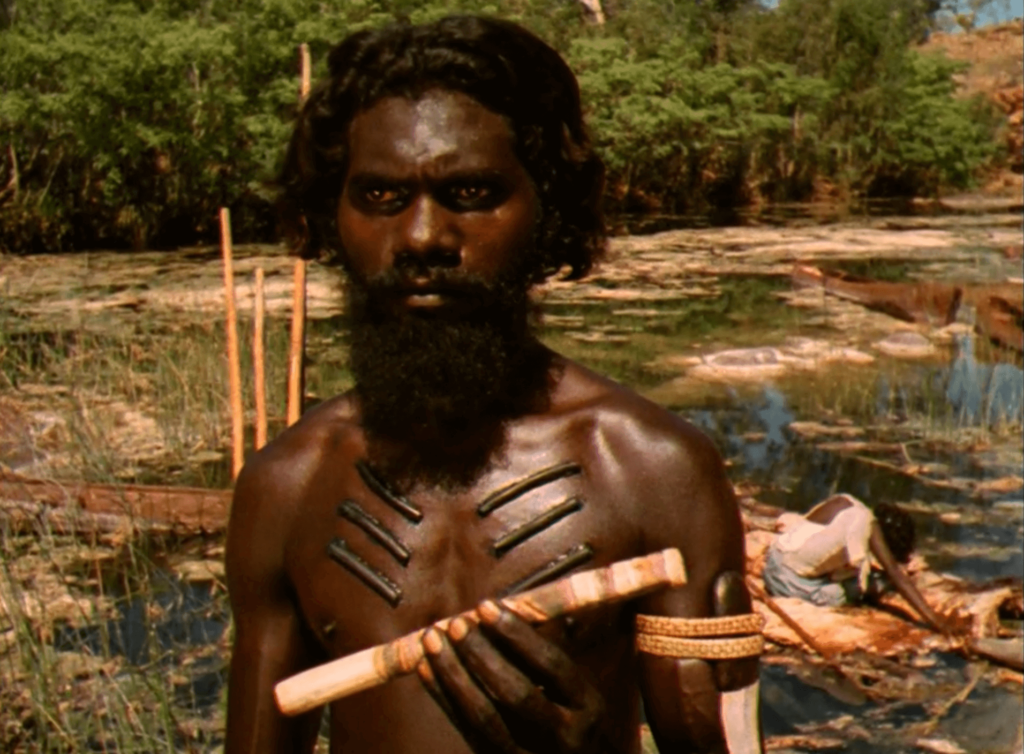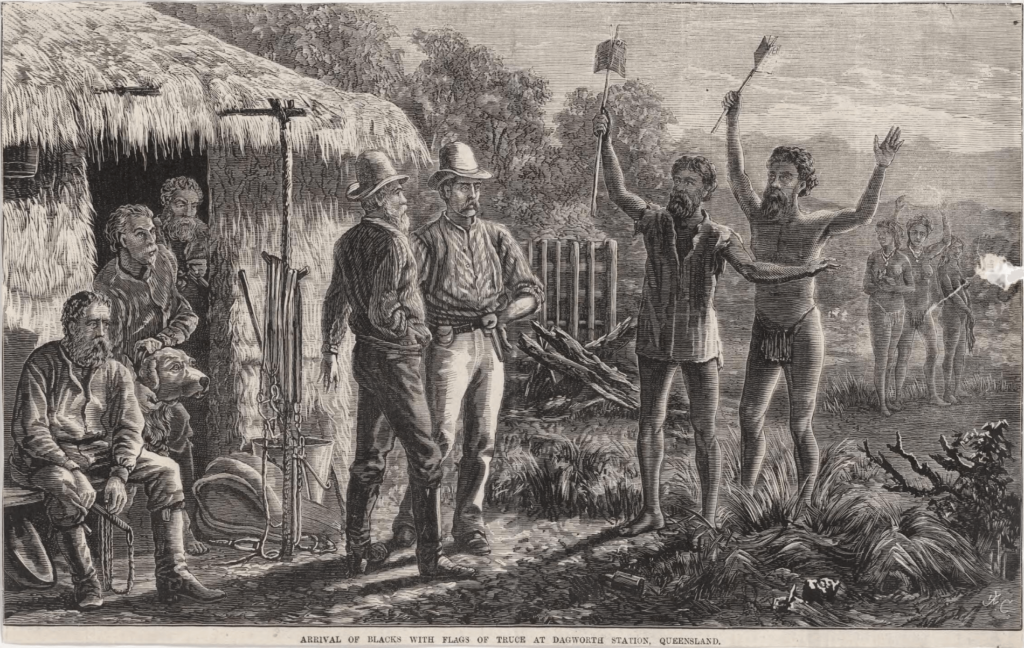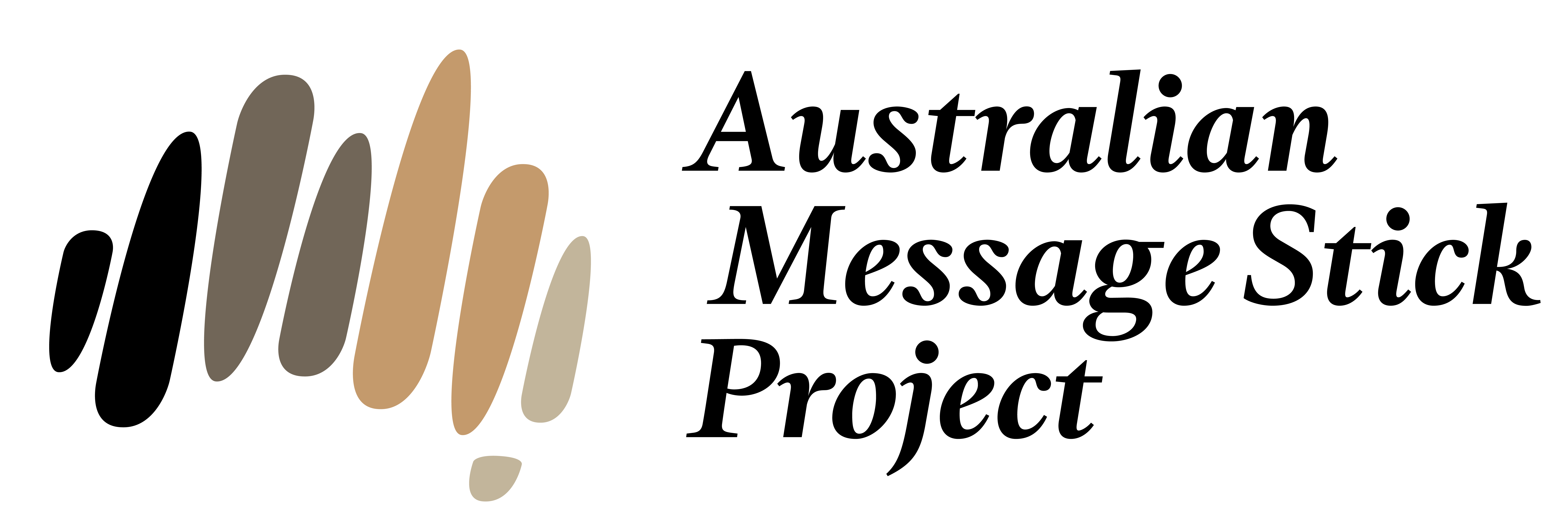We are seeking honours or postgraduate students who wish to pursue research topics related to message sticks. Eligibility is based on having completed relevant undergraduate coursework and/or professional experience. First Nations status is regarded as relevant experience in this instance.
The Australian Message Stick Project has three overarching research objectives:
- To define the status of message sticks as a distinct category of Australian material culture, grounded in Indigenous taxonomies, and supported by a large dataset of archival and field-derived evidence;
- To investigate the dynamic interactions between spoken language, graphic signs and context in message stick communications;
- To delineate the distribution of message sticks, plot their synchronic variation, and describe processes of adaptation and change across the colonial era into the present.
View the project team here.


Potential topics
Any feasible project on the topic of Australian message sticks will be considered. Below we have set out six broad project concepts that address essential—and tractable—questions about the history and practice of message stick communication. Please note that these are examples only and not pre-determined projects. Prospective students may reformulate any of these or develop independent topics.
Message sticks and the settler imagination
Message sticks became a minor sensation among the settler public in the 1880s and 1890s, attracting the interest of anthropologists, antiquarians and amateur collectors. Discussions around the functions of message sticks rarely involved direct consultation with Indigenous owners and the objects often became sources of speculation and fantasy. This project will consider settler representations of message sticks in colonial news reports, fiction and art, from the 1880s until the present day. It will consider how various stereotypes about the objects emerged — meaningless curios, proto-alphabetic texts, secret and sacred talismans — and how Aboriginal people have responded to these characterisations in complex ways.
Requirements: The candidate should have experience working with archival sources and be familiar with historiographic methodologies.
The message sticks of Ooldea Soak
The project will investigate the history, meaning and traditional ownership of message sticks sourced from Ooldea (Yuldea) Soak on the eastern edge of the Nullarbor plain. This permanent water source has been an important ceremonial site for neighbouring Aboriginal communities for over a millennium. With the establishment of the Trans-Australian Railway, and the founding of Ooldea Mission, patterns of mobility and contact in this region changed abruptly. Around thirty message sticks originating from Ooldea were collected and described by the likes of C. P. Mountford, Daisy Bates and others in the early twentieth century. The project will consider how these objects offer a testament to changing conditions and opportunities for Aboriginal people in this region.
Requirements: This is an historical ethnography topic meaning that the candidate should ideally have a background in history, anthropology or archaeology and be comfortable using primary sources. The student will develop, or already have, a working relationship with Traditional Owners.
Message sticks of Country
For Indigenous applicants only, this project involves identifying message sticks from your traditional Country or Countries that are locally owned and managed, conserved in a public collection or which survive only through descriptions, photographs or sketches. The project will investigate the life histories of these objects including the circumstances of their creation and circulation. Although the documentation is inadequate for almost all message sticks in contemporary collections, the project will explore their specific cultural and historical contexts, relying not only on colonial archives but on Indigenous oral knowledge and individual family histories.
Message sticks and German anthropology
Australia has been a site of special interest to German anthropologists since the late 19th century. Such important figures as Adolf Bastian (1826–1905), Herman Klaatsch (1863–1916) and Helmut Petri (1907–1986), among others, took, a great interest in message sticks which they collected and analysed during and after their visits to Australia. While settler-scholars tended to assume that message sticks were merely mnemonic devices, German ethnographers took an expansive approach, an attitude reflected in their more detailed descriptions and theoretical speculations. This project will trace the special contributions that German anthropologists made to the study and collection of message sticks from the 1880s through the two World Wars and the Cold War.
Requirements: The candidate will require sufficient competence in German to be able to make sense of historical archives, museum registers and journal articles (with the assistance of dictionaries and online translation tools). Travel to Germany is optional since the major sources are digitised, however the candidate will be expected to coordinate with German archivists and curators to negotiate digital access to additional materials. Candidates at UNE will also have access to any necessary German, Austrian and Swiss journals and may borrow a limited number of books from German libraries through international Inter-Library Loans.
Museum report
This project will entail a collection-wide examination of the message sticks held in any one major Australian institution such as the National Museum of Australia, Museums Victoria, the Australian Museum or the Queensland Museum. The candidate will begin by reviewing all message sticks in the collection and will subsequently focus on investigating a subset of them for more in-depth research, linking the objects and their collectors to archives beyond the museum. This will be a traditional dissertation—with an introduction, conclusion and references—but there may be an opportunity to publish it as an official museum report with the collaboration of the collecting institution.
Requirements: The candidate will need to travel to the museum and work on-site for a period of time. Funding for this travel is not available within the project but may be sought through the university or from other sources. Museums have strict access protocols and may request evidence of support for the candidate from Indigenous cultural organisations which can be time consuming to obtain. Indigenous scholars, or those with an existing relationship with a museum (eg, via an internship, or current or former employment) will be preferred.
Representations of number, time and space on Australian message sticks
The project will examine Indigenous strategies for representing concepts of number, calendrical time and geographic space on message sticks, and will suit a student enrolled within Archaeology or a related discipline. Shorter projects (essays or Honours dissertations) may focus on one of these concepts or on a set of specific artefacts. Longer studies will consider tally marks on message sticks in comparative perspective and engage with the theoretical work of Karenleigh Overmann, Stephen Chrisomalis and others, on global number-marking systems. The proposed study will focus on artefacts from the past 200 years that have been manufactured and directly interpreted by Indigenous message-senders, and consider how these recorded interpretations can inform or constrain our understanding of under-documented objects via cautious ethnographic analogy.
Requirements: The candidate should have a background in anthropology or cognitive science. This should be taken at a Masters level or higher.
A typology of message sticks
Extending the work of the archeaologist Anne Best, the project will use data from the Australian Message Stick Database to propose a typology of message sticks. The study will seek to understand the definition and scope of a message stick from an Indigenous perspective: what significant features or functions characterise a message stick? What kind of variation exists across the continent and what do such patterns reveal?
Requirements: The candidate should have a background in archaeology or anthropology
Message sticks in contemporary Australia
From the 1950s onwards, message sticks began to be used as a means of formalising public interactions between Indigenous and non-Indigenous institutions. Since that time, Aboriginal and non-Aboriginal people have developed new rituals and conventions concerning the creation and circulation of message sticks. This topic historicises the emergence of this phenomenon, exploring continuities with traditional message stick interactions up until the present day. It traces the increased presence of message sticks at the opening of public events, in parliaments, and in public activism. It considers standardised rituals of gifting or presenting message sticks alongside the parallel emergence of other pan-Aboriginal rituals such as Welcome to Country and smoking ceremonies.
Research resources for all topics
- The Australian Message Stick Database: contains images and relevant documentation for message sticks that are either conserved in collections or recorded in archives;
- The shared Endnote groups ‘Australian message sticks (general)’ and ‘Australian message sticks (Trove)’ contain a wealth of downloadable pdfs of primary and secondary sources on message sticks;
- Trove, permits searches for digitised documents managed by the National Library of Australia. Note that 1170 of the documents with the greatest relevance to message stick have been pre-vetted, downloaded as pdfs, and added to the Endnote group ‘Australian message sticks (Trove)’;
- The special collections of the State Library of New South Wales;
- The Corpus of Australian Contact History and Ethnography (Beta).
Before consulting any of these resources you are strongly advised to read through the texts listed in ‘A very short reading guide on Australian message sticks‘.
University of New England candidates
Prospective students enrolled at University of New England, Armidale, will be based in the School of Humanities, Arts and Social Sciences in the disciplinary area of History. Suitable postgraduate projects within Archaeology or Linguistics may also be considered.
Students with a First Nations background can benefit from Indigenous mentors and a community of experts based at the on-campus Oorala Aboriginal Centre.
The following options for independent research projects are available:
- BA Honours dissertation
- Minor Research Project (HUMS507, 6pts)
- Major Research Project (HUMS508, 12pts)
- MA Reading Unit (6pts, an essay of 6000 words)
- M.Phil dissertation (24 pts, an original thesis of 30,000–50,000 words)
See also HASS Special Topic Reading and Research Units.
Successful applicants will be supervised by Dr Piers Kelly and a staff member of the School. For dissertations only, research will need to be approved by an ethics committee. The university’s ethics process is outlined here. During or after the enrolment period, candidates may have the opportunity to submit parts of their work for publication in peer-reviewed journals, either independently or in collaboration with supervisors.
General information on how to apply for postgraduate studies at the University of New England is here.
Candidates based at other institutions
Candidates may also be enrolled at other Australian universities provided that they are able to find a principal supervisor at their home institution. Successful candidates would be co-supervised by Dr Piers Kelly.
How to submit an Expression of Interest
To submit an expression of interest please fill out the form below and send it to Piers Kelly (pkelly26@une.edu.au). This will need to be accompanied by a two-page CV and an academic transcript. Piers Kelly will respond within one week. Please note the the University of New England has a separate EOI process here that is substantially more involved! The EOI below is just a way of saying ‘hi’ to the project team. We will be able to help you navigate the UNE administration if we feel you have a good project in mind and the capacity to carry it out. We can also point you towards scholarship opportunities.
